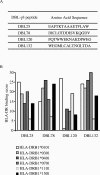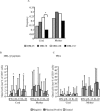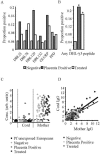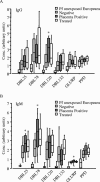Neonatal and maternal immunological responses to conserved epitopes within the DBL-gamma3 chondroitin sulfate A-binding domain of Plasmodium falciparum erythrocyte membrane protein 1
- PMID: 16299291
- PMCID: PMC1307047
- DOI: 10.1128/IAI.73.12.7988-7995.2005
Neonatal and maternal immunological responses to conserved epitopes within the DBL-gamma3 chondroitin sulfate A-binding domain of Plasmodium falciparum erythrocyte membrane protein 1
Abstract
Plasmodium falciparum erythrocyte membrane protein 1 (PfEMP1) mediates the adherence of P. falciparum-infected erythrocytes to placental syncytiotrophoblasts via interactions with chondroitin sulfate A (CSA), a characteristic of pregnancy-associated malaria. Pregnancy-associated malaria predicts increased susceptibility of newborns to malaria, and it is postulated that transplacental passage of parasite antigen induces immune regulatory activity in the neonate. We wished to examine the immune responsiveness to a CSA-binding domain of PfEMP1, the DBL-gamma3 domain, in cord and maternal venous blood obtained from pregnancies with various histories of P. falciparum infection. We assessed in vitro T-cell cytokine and plasma immunoglobulin G (IgG) and IgM responses to four peptides corresponding to highly conserved regions of a DBL-gamma3 domain common to central African parasite isolates. The presence of placental P. falciparum infection at delivery was associated with elevated frequencies of DBL-gamma3 peptide-specific CD3+ interleukin-10-positive T cells in cord blood, while treatment and clearance of infection prior to delivery was associated with elevated frequencies of CD3+ gamma interferon-positive T cells. DBL-gamma3 peptide-specific IgM antibodies were detected in 12 of 60 (20%) cord plasma samples from those born to mothers with P. falciparum infection during pregnancy. Consistent with polyclonal anti-PfEMP1 antibody responses that are associated with protection against pregnancy-associated malaria, the presence of maternal IgG antibodies with specificity for one of the DBL-gamma3 peptides showed a parity-dependent profile. These data demonstrate that peptides corresponding to conserved regions of the DBL-gamma3 domain of PfEMP1 are immunogenic in P. falciparum-infected mothers and their offspring.
Figures





References
-
- Allsopp, C. E., L. A. Sanni, L. Reubsaet, F. Ndungu, C. Newbold, T. Mwangi, K. Marsh, and J. Langhorne. 2002. CD4 T-cell responses to a variant antigen of the malaria parasite Plasmodium falciparum, erythrocyte membrane protein-1, in individuals living in malaria-endemic areas. J. Infect. Dis. 185:812-819. - PubMed
-
- Brustoski, K., U. Moller, M. Kramer, F. Hartgers, P. G. Kremsner, U. Krzych, and A. J. F. Luty. Reduced cord blood immune effector cell responsiveness mediated by CD4+ T cells induced in utero as a consequence of placental Plasmodium falciparum infection. J. Infect. Dis., in press. - PubMed
-
- Brustoski, K., U. Moller, M. Kramer, A. Petelski, S. Brenner, D. R. Palmer, M. Bongartz, P. G. Kremsner, A. J. Luty, and U. Krzych. 2005. IFN-gamma and IL-10 mediate parasite-specific immune responses of cord blood cells induced by pregnancy-associated Plasmodium falciparum malaria. J. Immunol. 174:1738-1745. - PubMed
-
- Buffet, P. A., B. Gamain, C. Scheidig, D. Baruch, J. D. Smith, R. Hernandez-Rivas, B. Pouvelle, S. Oishi, N. Fujii, T. Fusai, D. Parzy, L. H. Miller, J. Gysin, and A. Scherf. 1999. Plasmodium falciparum domain mediating adhesion to chondroitin sulfate A: a receptor for human placental infection. Proc. Natl. Acad. Sci. USA 96:12743-12748. - PMC - PubMed
-
- Costa, F. T., T. Fusai, D. Parzy, Y. Sterkers, M. Torrentino, J. B. Douki, B. Traore, S. Petres, A. Scherf, and J. Gysin. 2003. Immunization with recombinant duffy binding-like-gamma3 induces pan-reactive and adhesion-blocking antibodies against placental chondroitin sulfate A-binding Plasmodium falciparum parasites. J. Infect. Dis. 188:153-164. - PubMed
Publication types
MeSH terms
Substances
LinkOut - more resources
Full Text Sources
Medical
Research Materials

